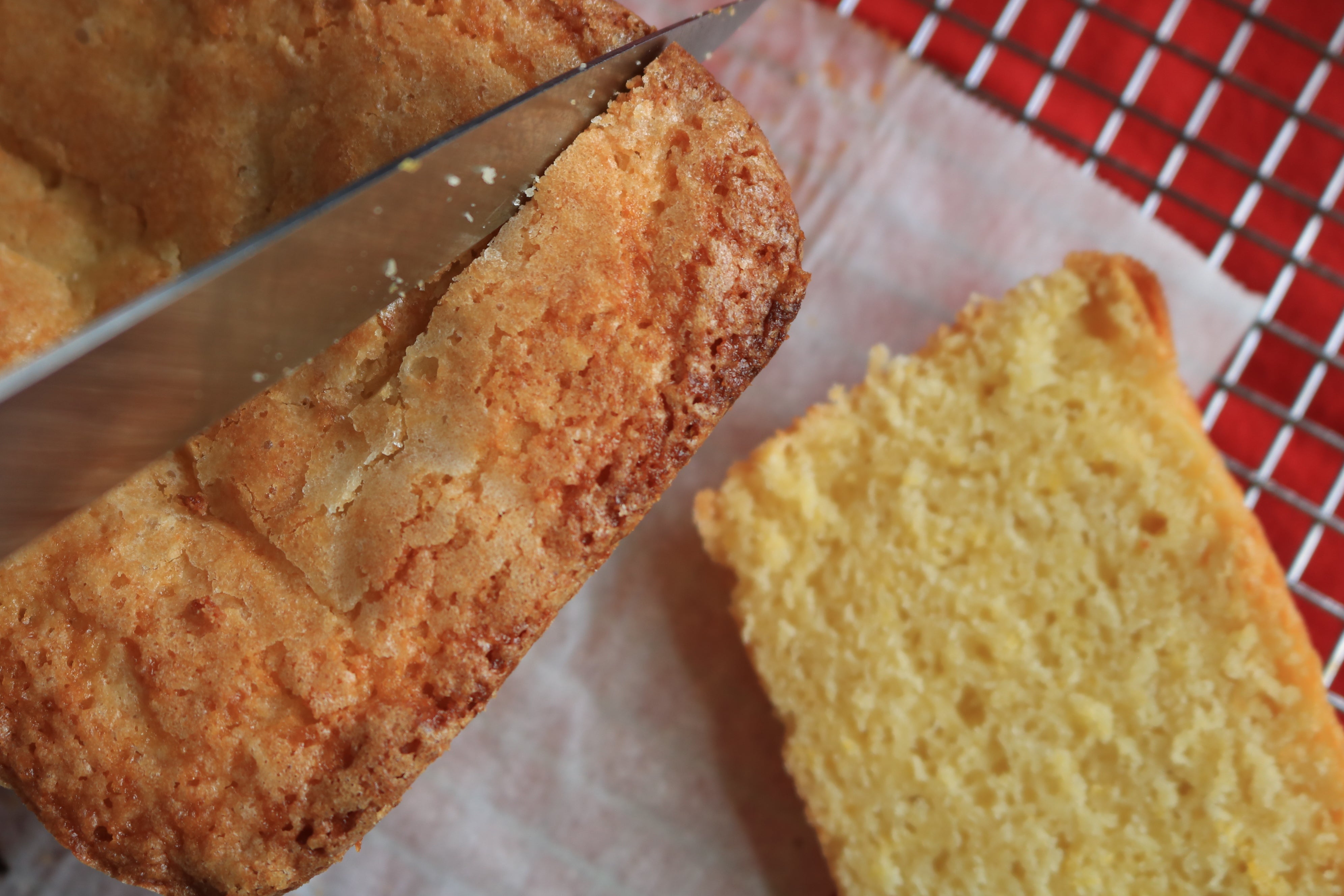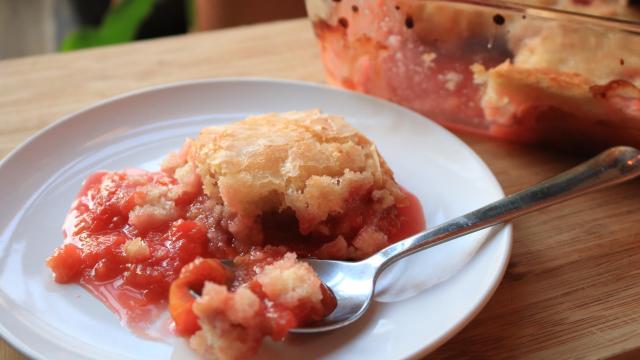There are very few cake “improvements” that I trust right away. I’m a food sceptic by nature, and I usually stare at viral hacks and food tricks with squinted eyes until I’m convinced. That’s how I was when I assessed Renee Erickson’s peach cobbler with hot sugar crust before testing it out. But after taking one bite, I can happily report that not only is it darn delicious, but that this technique can add a sweet crackly top to a number of different baked goods. Just make sure you steel yourself for the moment you dump water all over your cake.
Cake is usually topped with some kind of frosting or glaze, maybe chopped nuts, fruit, or ganache. These are all great, but a hot sugar crust is a cake topping unlike the rest. Instead of being added after the dessert has baked and cooled, the hot water dissolves the granules of sugar, then forms a crust as it evaporates during baking. Don’t mistake it for a brulée sugar topping — far from being a hard caramelised casing, the hot sugar crust is translucent, delicate, crisp, and ultra-thin. Your fork pierces through the crackling layer of sugar and plunges into the plush crumb of the underlying cake, making every bite an exquisite combination of textures.
Why you should pour hot water on your cake batter
Some of my initial worries were due to this concept of hot water being poured onto the batter before baking. (OK, all of my worries stemmed from that.) I’ve heard of this method for baking lasagnas, but cake? Nope. What if the hot water makes the butter melt out? What if it becomes waterlogged? What if it makes the cake tough? What if it doesn’t make a crust at all? All of my doubts were laid to rest for the same reason: it comes down to the mixing method.
The order of adding ingredients and the manner in which they meet each other ensures the water you add to the top of the dessert doesn’t interact with any ingredients it’s not supposed to, specifically the butter and flour.
The first step for the cake batter portion of Erickson’s peach cobbler is to cream together the sugar and butter, a pretty standard start to most cake recipes. Normally eggs and liquids would follow. This isn’t so for Erickson’s hot sugar crust — instead, flour is added to the butter and sugar mixture. The flour is pressed into the fat until it’s evenly crumbly before the milk is added. This process is called “water-proofing” the flour. This technique is sometimes used with pie dough, like in this recipe from Cook’s Illustrated. The idea is that you rub butter or shortening thoroughly into the flour so that the saturated fat coats most of the flour particles, making a barrier that water can’t penetrate. This protects some of the flour from absorbing water, which prevents gluten bonds from forming, and in the case of a hot sugar crust, prevents excess water from soaking into the batter and destroying it.
You can add any fruit to your cake
My grocery store only carries decidedly unripe peaches so I tested out the peach cobbler recipe with some lovely red plums instead. I loved that this cobbler called for very little fruit preparation — simply cut the plums in big hunks and take out the pit. No need to remove the skin or par-cook anything, no need to even add sugar, just a squeeze of lemon and some zest. Beyond stone fruit, I imagine that a heap of ripe berries or chunks of pineapple would work just as well.
Once I mixed up the batter and spread it evenly over the fruit, I prepared for the nerve-wracking moment — a hot water puddle. Except it was so easy and straightforward I barely had time to be worried. I covered the batter with a healthy dose of granulated sugar, then dribbled a small amount of hot water over it. In my imagination, the cake was going to be submerged under a great sea of sugar-water, but in reality it was just enough water to create a shallow puddle over the cobbler. Don’t skip it though — this is very different from simply sprinkling on granulated sugar without the water. This procedure restructures the sugar as a flat sheet, coating every ripple and divot of the dessert.
Once it cooled I saw a thin, shiny, sugary ice rink over the surface of the cobbler. The resulting dessert was comprised of soft, tangy pieces of fruit that only just began to make my lips pucker when a crisp scale of sugar would swoop over on a raft of soft cake to temper the acid. Unceasingly sceptical, I looked at the cobbler and thought, “after a couple hours, the humidity is going to make this a sticky mess.” Not only did it stay crisp through the rest of the day, but I covered it with a cracked Tupperware lid and surprisingly the crust remained crunchy even the next day.
Hot sugar’s other applications
Erickson’s recipe was intended to top a fruit cobbler, but this candied concept can work in other places with batter. Try it on a snack cake, a loaf cake, or make a batch of sugar-topped brownies. Depending on the surface area of the dessert, you’ll need enough sugar to coat the top with a mostly opaque layer of sugar, with some spots disappearing into the moisture of the batter. Drizzle on just enough hot water to dissolve all of the sugar, with no more than ¼ inch of water puddling in any given area. I created the following recipe to springboard off of the fruit cobbler idea. Honestly, I wanted more of the cake part. If you like less fruit and more cobble then this recipe is perfect for you; there’s all the tang of lemon with none of the sourness, and plenty of crunchy-chew from the hot sugar crust on top.
How to make lemon loaf with hot sugar crust

Ingredients:
- 1 stick butter (softened)
- 1 ¼ cup sugar
- 1 ½ cup flour
- ¾ teaspoon baking powder
- ¼ teaspoon baking soda
- ½ teaspoon salt
- 2 eggs
- 2 lemons (zest and juice)
- 4 teaspoons sugar (for crust)
- ¼ cup of hot water
Preheat oven to 180°C. Prepare the loaf pan by buttering the inside and lining it with parchment paper. Leave short flaps on the sides so you can lift it out easily later. Place the loaf pan on a sheet tray. Heat ¼ cup of water and set aside.
Put softened butter and sugar in a large bowl and mix together until a homogenous paste forms. Add flour, baking powder, baking soda, and salt to the butter mixture. If you’re using a stand mixer, mix on low speed with a paddle attachment until the dry ingredients are completely incorporated. If working by hand, use a rubber spatula and work the dry ingredients into the butter slowly by pressing to combine. Once the flour is fully mixed in, the mixture will look evenly crumbly. Add the eggs, zest of both lemons, and lemon juice. Mix thoroughly and quickly.
Pour the batter into the prepared loaf pan and smooth out the top so it makes contact with the sides. Sprinkle four teaspoons of sugar so it coats the entire top of the batter. Dribble the hot water over the surface of the cake so it dissolves the sugar.
Bake immediately at 180°C for 45 minutes. The edges will begin to brown and a toothpick inserted into the centre will come out clean. Cool completely and enjoy plain or with a scoop of ice cream.

Leave a Reply
You must be logged in to post a comment.